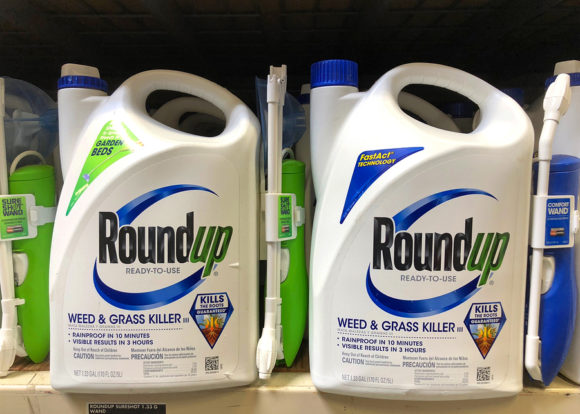Scientists can’t, for the most part, prove that a given product caused a particular person to get cancer – not the way you can prove, say, that a car with faulty brakes caused a fatal crash. And so when a federal jury in San Francisco District Court decided that the weed killer Roundup was a “substantial factor” in causing someone to get a type of cancer called non-Hodgkins lymphoma, they didn’t actually have proof for the individual case. What they had was evidence that the product was a probable factor in the man’s cancer, based on studies that follow large populations.
Of course science should be the deciding factor in such cases, but there’s no sense in implying that scientists can do the impossible. What scientists and society at large have come to agree upon is that it’s reasonable to award people compensation if it’s more likely than not that they would have avoided the cancer if they’d been able to avoid the product in question. This latest verdict, announced yesterday, is the second in favor of a plaintiff who got cancer after using Roundup, made by Monsanto, which was recently acquired by Bayer. In the first case, the plaintiff was awarded $80 million.
Why can’t scientists prove individual cancer cases? Cancer epidemiologist Richard Stevens of the University of Connecticut explains using a seemingly straightforward example: cigarettes. There’s abundant evidence that they cause lung cancer. But some nonsmokers get lung cancer, and many smokers never do. This is because there are other factors at work in the determination of who gets cancer, including, some say, random copying errors in DNA.
There will always be a few smokers who would have gotten lung cancer regardless of their smoking habits. So scientists can say smoking causes cancer in the population at large, but can’t say for sure that Uncle Joe’s lung cancer was caused by his smoking habit.
The same thing goes for ionizing radiation, which is a well-studied cause of cancer. There, scientists have the advantage of data gathered from the survivors of the Hiroshima bombing, which show the higher the exposure, the greater the cancer risk.
That means if an exposed worker from a nuclear weapons facility gets cancer, and she’s worn a dosimeter to measure her exposure, it’s possible to calculate how likely it is that she would not have gotten cancer if not for the exposure.
But as Stevens says, once you do that analysis, you’re left with the thorny issue of deciding how much probable causation should lead to compensation for plaintiffs. If it’s 99 percent likely that a product caused your cancer, it’s easy, but what if there’s just a 10 percent chance that the product had anything to do with the disease? For most such cases, people have settled on 50 percent.
When scientists try to determine what’s a potential carcinogen, they can also use evidence from basic biology – does the substance damage DNA in a test tube? – as well as evidence from animal studies. It was a mix of these kinds of evidence that led the International Agency for Research on Cancer (part of the World Health Organization) to declare Roundup a probable human carcinogen in 2015. Meanwhile, the U.S. Environmental Protection Agency has deemed the herbicide most likely not a carcinogen.
A new paper combining different human studies was published in the February issue of the journal Mutation Research. The authors concluded that “overall, in accordance with evidence from animal experiments and mechanistic studies, our current meta-analysis … suggests a compelling link between exposure to GBHs [the active ingredient in Roundup] and non-Hodgkins Lymphoma.”
On the face if it, this new study looks quite good, said UCLA statistician and epidemiologist Sander Greenland, who corresponded with me by email. As for cause and effect, there is no consistent definition in law or science. In both arenas, people usually define cause as a counterfactual statement: “Both reduce to saying X caused Y if Y would not have occurred if X had not acted or occurred.”
But for cases like the current Roundup trial, Greenland said, “such counterfactuals cannot be established for individuals, so both law and science have to fall back on probabilities of causation, and there, things get so complicated that both jurists and scientists make huge blunders in connecting this concept to real data.”
To illustrate how, he sent several articles he’s co-written, including this one in the Bulletin of the Atomic Scientists. There, he cautioned that the current system for estimating probable cause could grossly underestimate the number of people affected.
That’s because there’s an underlying assumption that someone was either going to get cancer or not. But in reality, a person exposed to radiation might have gotten cancer at 70 with no exposure, but instead gets sick at 66. Radiation, and other carcinogens, might accelerate cancer and thus rob people of healthy, productive years. He suggests that scientists calculate average years of lost life to determine compensation.
That deserves a closer look, because it could produce a fairer system of compensation and could avoid the problem of using the language of “proof” to describe probabilities. According to the New York Times, about 11,200 other people are also suing Monsanto over Roundup, so there will be plenty of opportunity to improve the way science is used in a courtroom and the way it’s communicated.
Topics Pollution
Was this article valuable?
Here are more articles you may enjoy.



 Warburg Mulls $1 Billion Sale of London Insurance Broker McGill
Warburg Mulls $1 Billion Sale of London Insurance Broker McGill  Adjusters Launch ‘CarFax for Insurance Claims’ to Vet Carriers’ Damage Estimates
Adjusters Launch ‘CarFax for Insurance Claims’ to Vet Carriers’ Damage Estimates  SIAA Announces Strategic Partnership With Progressive
SIAA Announces Strategic Partnership With Progressive  Florida Lawmakers Ready for Another Shot at Litigation Funding Limits
Florida Lawmakers Ready for Another Shot at Litigation Funding Limits 

